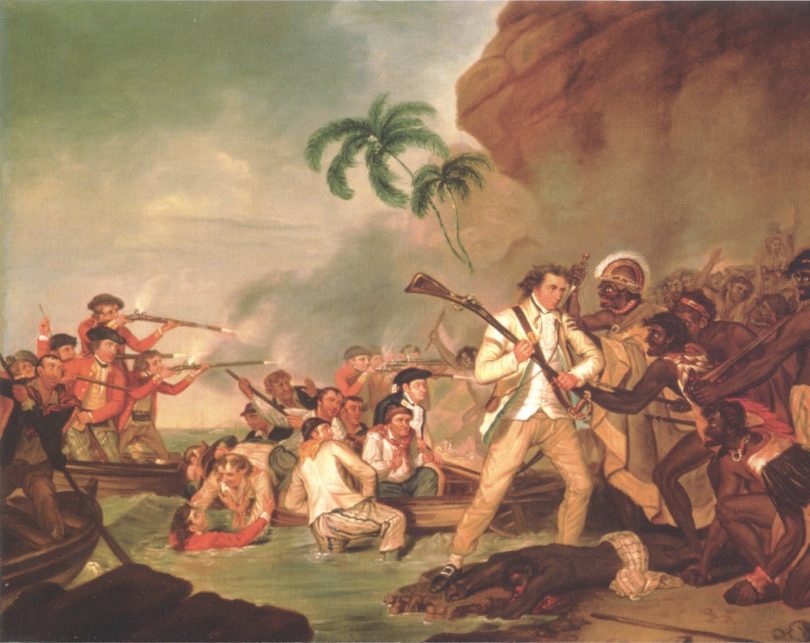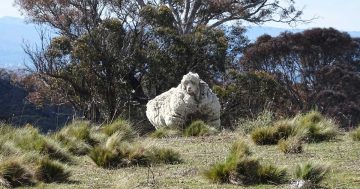
Death of Captain Cook, by George Carter, is part of the Cook and the Pacific exhibition. Image: Supplied.
The scene on the beach must have been complete mayhem. Gentle waves lapped Kealakekua Bay on St Valentine’s Day 1779, but on land, there was bloodshed and chaos as Captain James Cook and four of his men were murdered by a crowd of angry Hawaiians.
Sometimes a single object can transport you to the scene. And so it is in the National Library’s Cook and the Pacific exhibition, where the actual pahoa dagger reputed to have been plunged into the great navigator hangs on a wall, browned by time.
Cook and his men had previously enjoyed idyllic stays on the islands, their visit coinciding with a Hawaiian fertility festival dedicated to the god Lono. Goods were traded for sexual favours by Cook’s men, and the islanders saw them initially as supernatural beings, perhaps even gods.
But relations soured when the crew returned for repairs on HMS Resolution. Tensions rose, a small boat was stolen and Cook determined to ransom the local king for its return. He was attacked while leading the king towards boats on the beach.

Pahoa (Dagger) of Swordfish Reputed to Be the One Which Killed Cook c. 1779 Hooper Collection, Bernice Pauahi Bishop Museum, Honolulu, 1977.206.013 Photo by Jesse W. Stephen, copyright © Bishop Museum, 2018; Bishop Museum Archives
There’s much that’s unclear about the story. Was Cook stabbed in the back, as legend has it? Was there a single killer or more than one assailant among the angry crowd? Could a dagger whittled from a swordfish bill be a murder weapon?
Cook and the Pacific co-curator Susannah Helman says we may never know with certainty, but that persistent stories have centred around this dagger from the Bernice Pauahi Bishop Museum, Hawaii’s State Museum of Cultural and Natural History.
The weapon is certainly genuine: Hawaiians used spears, slings, and clubs in combat and daggers were often deployed at close quarters. Pahoa ranged in size, depending on the person wielding them. Generally, they have a long blade and handle, allowing for a strong grip. It seems a likely weapon for a warrior.
Helman says the dagger was collected during the voyage of HMS Blonde, which sailed to the islands in 1825 with the bodies of the King and Queen of Hawaii who had died in England. The dagger was found at a secret burial ground, which again seems likely: Cook was accorded great respect after his death according to traditional Hawaiian burial practises.
“It comes from the right area, and it has the story attached,” Helman says. “It’s originally from the collection of James Hooper and was then purchased by the Bishop Museum. Cook’s death was a violent and confused scene, but expert research suggests that this particular dagger is the one most likely to have been involved in Cook’s death.
“None of the artists who depicted Cook’s death was actually there at the time, so we may never be absolutely certain, but it’s an extraordinary honour to be able to display it here.”
The pahoa dagger is just one of the extraordinarily rich assemblage of objects in the exhibition, among them Cook’s own handwritten journals: two from the British Library in London and the NLA’s own prized Endeavour Journal, purchased for 5000 pounds at a Sotheby’s auction in 1923.
NLA Director-General Dr Marie-Louise Ayres says the exhibition displays “the most complete set of Cook’s major Pacific voyage journals in his own handwriting….they are Cook’s own record, in his own words, of how he experienced the three Pacific voyages from 1768 until his death in 1779.”
Cook’s last logbook, also on loan from the British Library, is also part of the exhibition. It ends on January 17, 1779 – about a month before his gruesome death.
“There is something for everyone here,” Susannah Helman says. “For people who like maps, manuscripts, portraits and science, language and interactive word lists, how people everywhere have reacted to Cook and his voyages through art, humour and politics.”
Cook and the Pacific is open at the National Library of Australia until 10 February. Free entry.
















